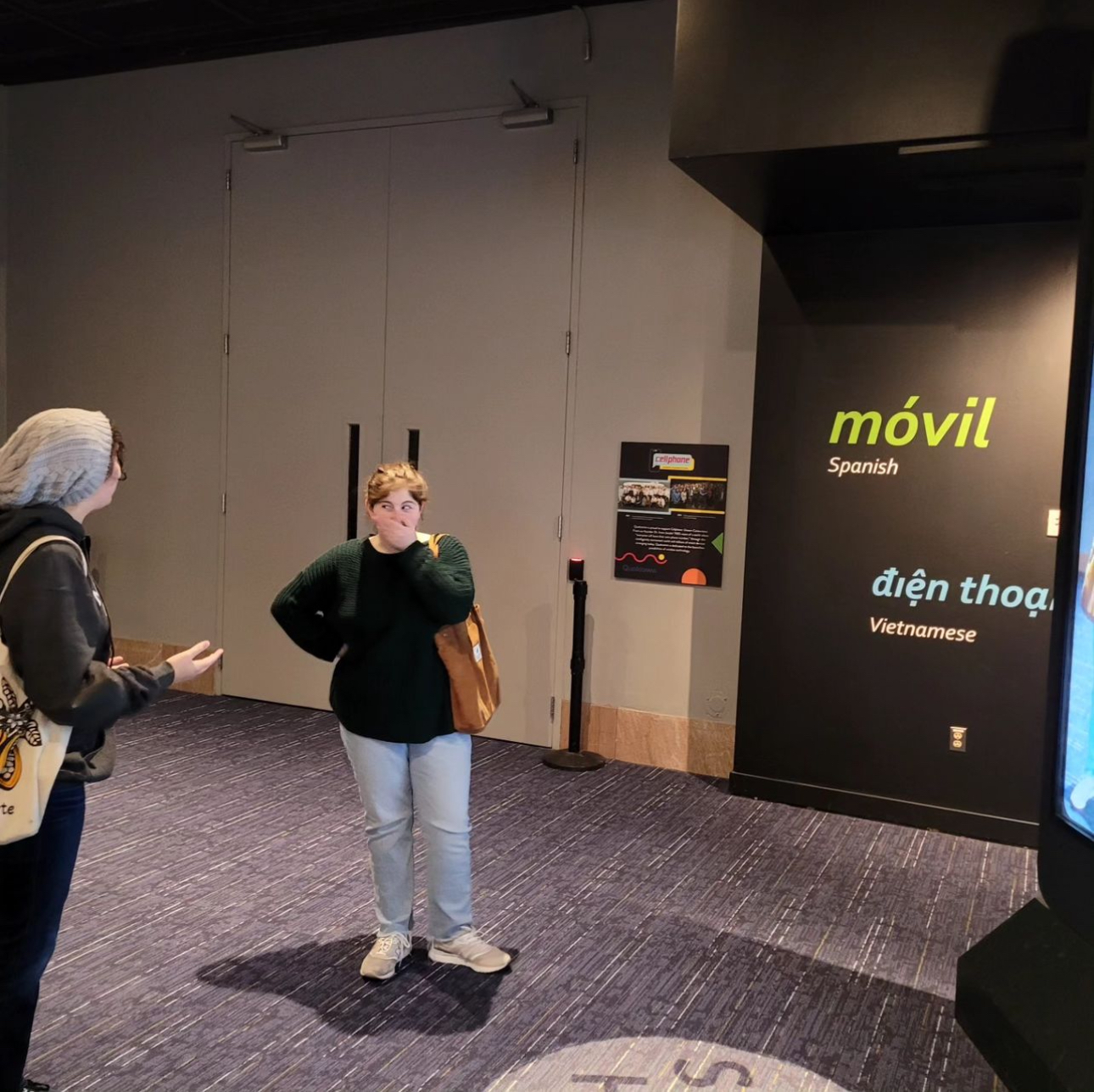Field Trip:
National Museum of Natural History, Washington, DC (Dec. 2):
On December 2, 2023 I went to the National Museum of Natural History Museum in DC. There were four main exhibits that we had to go to: “Cellphones: Unseen Connections,” “Humans Change the World,” “The Changing Ocean,” and various smaller exhibits in “Climate Change in the David H. Koch Hall of Fossils–Deep Time.”
Within the “Cellphones: Unseen Connections” exhibit, there were a lot of different versions of informational media. When we first walked into the exhibit, we were greeted by four large screens, posing to be an interactive emoji phone. While we could play with expressions and the emojis on screen, while having different fun facts appear on the screen. After that, there are other versions of learning based media. There’s signs, games, videos, and even comic strips. Personally, I don’t think the combination of all of these different types of media is effective. There’s almost too much information and stimuli that can be seen as a little too overwhelming. However, I did find the videos more informative and helpful than anything else.
A part of this first exhibit discussed the environmental issues of cellphones. Some of the environmental issues pertain to the minerals used in the phones. A good amount of the materials used to make key components of phones are toxic and dangerous. Disposing of these minerals is hard. Plus we would have to rely on people to actually dispose of these parts correctly.
Thankfully, the entire exhibit is not doom and gloom. There are some great social and technological impacts cellphones have. There were a few signs and audio aids describing how phones can help people in more rural areas connect to others and run their businesses. Plus now, phones are more efficient. There was a sign describing what Carbide Corporation does to help develop next-gen materials to keep microchips from overheating in tech.

Yay, me and my roommate! Credit to Dr. Holtz for this photo (taken from the SGC Instagram
In the second exhibit, “Humans Change the World,” it covered many different topics about human evolution and how we have changed the world. Through text and visual representation (models and videos), this part of the hall explains how we accelerate global change and our animal conception. Another way this exhibit shows how humans change is through the skulls (visual representation). Our skulls got rounder and our cheekbones got softer. This section represents evolution. Then it also shows how our communication has evolved (another form of visual representation). We used hand paintings to communicate and can see how early human communication turned from hand markings to writing. We went from:
Cave Paintings -> Recording Info -> Expressing Identity -> Communicating With Color -> Talking
Even though some critics of the hall say that it de-emphasizes the human impact on the environment and climate, I would argue that this isn’t the purpose of this part of the “Humans Change the World” exhibit. There's an entire room dedicated to Climate Change and mentions of it are made elsewhere. And this exhibit is to show how humans change and not their climate impact so I would agree with the critics, but I would argue that this purpose is not necessarily a bad thing. We should be able to celebrate how amazing humans can be.
The first video I watched was called “Hurricane Hunters.” It taught how descriptive hurricanes can be and how people can measure the structure of the storm to help determine how bad the damage can be. The second video I watched was “No Sunlight No Problem.” It covered the different animals that live at the bottom of the sea in Hawai’i. Personally, I don’t think a general visitor could learn or understand this. It’s a little too brief and some of the videos are mislabeled on one of the consoles. However, “No Sunlight No Problem” was easier to understand than “Hurricane Hunters” because it was slower (easier to process information) and it’s simple, but it could have been a little longer.
The “Global Ocean Video” talks about a variety of topics, including: water, tectonic plates, Pangea, plate moment triggers earthquake, wave patterns, and more. The sphere is used to help portray the depth of the ocean all over the globe. It provides an easily recognizable way to see where each tectonic plate is and is a good way to see how the plate changes over time. Plus, it is visually interesting to look at, and that can keep attention. While the video was very useful, it was very long and repetitive. After some time, it becomes tiring to watch and it is just easier to walk away.
There are pylons in Koch Hall that depict different life and environments at different points in time. There were two pylons that I looked at. The first pylon was titled “Grasslands Far and Wide” and covered the area in Harrison Formation, Nebraska around 24-16 million years ago. In this time period the CO2 levels were 50% higher than our current CO2 levels, the average global temperature was 5-12 degrees Fahrenheit greater, and their sea levels were 330 feet higher than today. The second pylon was called “Lush Rainforests” and was in Willwood Formation, Wyoming around 56-53 million years ago. Their global CO2 levels were 5 times higher than ours today, the average global temperature was 14-25 degrees Fahrenheit higher, and their sea levels were 720 feet higher than today.
In my opinion, these pylons are a great way for learning about Climate Change. They aren’t visually too over stimulating and present all the information needed. Plus, they are kinda cute.
In the last section of the Koch Hall area, there was a mini section on Climate Change at these little kiosks. Firstly, during the Devonian period, sea levels and CO2 levels were moderately high, but the temperature was very cold. During the Permian period, the sea level, temperature, and CO2 levels were much lower than what we have today. In this particular period of time, the Paleozoic Ice Age ended. Then, during the Cretaceous period, the sea levels and temperature were extremely high compared to today’s levels, while the CO2 levels were only moderately higher. In this section of the exhibit, the screens display a timeline of the different periods of Earth’s history and give us a short image and caption to describe the time. Along with a visual of where this happened, geographically, there are three bars that represent: the sea levels, temperature, and CO2 levels. On these bars, it shows the time period’s measurements in comparison to today’s measurements. I think this exhibit doesn’t effectively communicate the fossil and geological information because it fails to present this important information without clicking throughout the UI and can be hard to find. For example, me and my roommate took fifteen minutes to find these information boards because everything else was so visually distracting, that we thought that was the important information.


